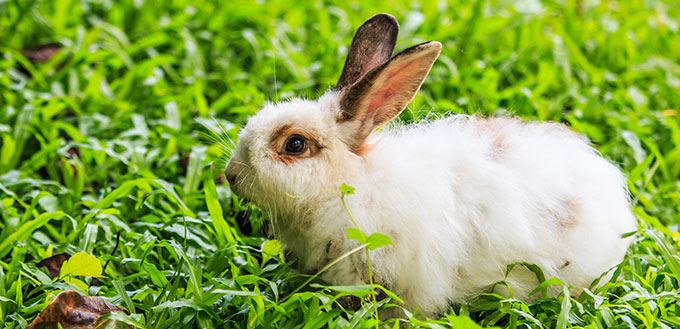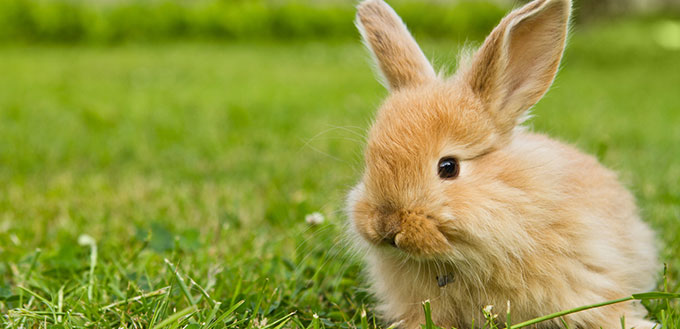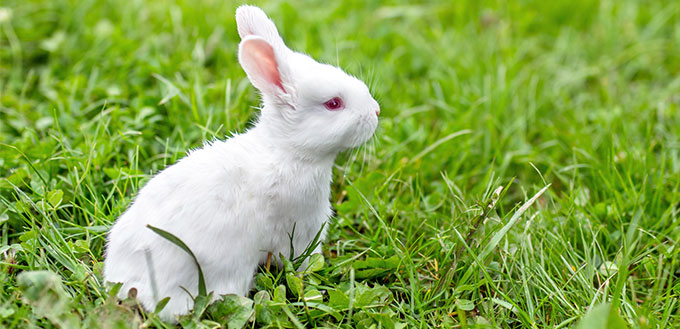There are many circumstances which could find you taking care of a kit, which is the official term for a baby rabbit. You may have access to an active mother rabbit who will nurse and care for the babies or you may be in it alone. Perhaps your rabbit became pregnant, or maybe you found an abandoned baby bunny in your local forest. Ultimately, if you are caring for a baby bunny, you need to care for them very diligently as they are usually vulnerable and very fragile, so here is our guide to doing just that!
Preparation is Key
If you have a pregnant rabbit, you have the benefit of time. Pregnancy lasts approximately 32 days and during this time there are important things you can do for your mother rabbit that will help your baby rabbits when they are born. Some may be more obvious than others, but it will help you feel confident that you know what you are doing.
- Do your research. You probably are already aware of this step if you are reading this article, but it is crucial to stress how important it is to be prepared for any eventuality. Even if you have a mother rabbit who you expect will nurse your kits, don’t skip any advice about nursing them yourself as you never know what will happen.
- Make sure the mother gets the right diet. Pregnancy does not change a rabbit’s diet very much, but it essential that a mother is provided with what she needs. The best rabbit food will provide her with:
- A minimum of 19% fiber
- A minimum of 17% protein
- A maximum of 3% fat
- Fiber and protein should, preferably, make up around 40% of their diet.
- She also needs fresh water three times a day and can benefit from additional protein in the form of alfalfa hay or cubes. Do not overfeed her as an overweight mother can put the health of her babies at risk.
- Move her away from the father. Rabbits bond to one another very closely, so you do not want to move them too far away from one another. Preferably, you should put them in a situation where they can still see, and even touch, each other, by segregating the hutch with some mesh or a large, spacious rabbit cage. The reason you have to do this is to prevent further pregnancy. Rabbits really have earned their reputation as prolific breeders, but another immediate pregnancy will be bad for your baby bunnies because it can stop her from nursing an existing litter.
Make a nest box. Rabbits in the wild create nests to keep babies warm because they are born without fur and are vulnerable to the elements. The box, which can be cardboard, should be a little bit bigger than the mother and needs to be filled with a clean towel and some pesticide-free grass, rabbit hay or straw. The box needs to be shaped so that the mother can hop in and out, but the babies cannot, so lower one of the walls to at least one inch. Keep the nest away from the mother’s litter box and in a dark, calm place.

Newborn Rabbits
Unsurprisingly, after pregnancy comes the birth. Luckily, your mother rabbit, or doe, does not need any help with this. Birth usually happens during the night or very early in the morning, so you are likely to just wake up one day to the sounds of sweet mewing. When this happens, you must first check that each of the baby bunnies is healthy.
Some may not have survived the birthing process, this is, unfortunately, natural and common in large litters. There will also be placenta and afterbirth to remove from the box. It can be difficult to remove these things with the mother in the box, so you may need to entice her to leave using a treat.
There may be kits that were born outside the box. These kits will need immediate, but not too sudden, warmth. You can do this by filling a hot water bottle with warm water, wrapping it in a towel, and placing it beneath the bedding. Do not let any animal touch the water bottle directly, as it will be too warm, and do not use boiling hot water. Keep in mind that you are meant to be replicated the warmth provided by body heat, so if the water is too hot for you to touch, it is too hot for the babies.
It is not uncommon in the wild for a hungry doe to turn to cannibalism, so it is essential to provide your mother rabbit with all the food she needs, taking into account that nursing is a demanding process on the body. Provide her with constant access to fresh food and water and keep this food balanced as outlined above. Without this constant source of sustenance, your doe may not produce enough milk to feed her young.
Hopefully, with enough food and water, and without further pregnancy, your mother rabbit will successfully nurse her litter. Nursing generally happens as little as once or twice a day, and does naturally spend most of their time outside the nest. Don’t be too alarmed if you do not see nursing taking place, but you should still seek to confirm that it is happening. Signs that nursing is happening include:
- Babies with round, full stomachs
- Babies that are warm and content
- Babies that are quiet and peaceful
A kit that is hungry will be cold and mewling like a cat for attention. If you suspect that your doe is not feeding her babies you should call a vet immediately. There can be many reasons for this outside of your control, such as illness, so it is essential for a professional to examine the rabbit family to discover what may be wrong. They can also advise you if you need to start feeding the baby bunnies yourself.
Caring for a Baby Bunny
If all is well with your kits and their mother, there is still plenty to do to support their growth. You need to keep them happy and healthy by caring for them and their environment. First and foremost, you need to make sure their environment remains hygienic. Newborn rabbits are very vulnerable to illness and disease and, as you might imagine, living your entire life in a small box will mean that they are eating and sleeping in the same place they are defecating. To keep them healthy, everyday you must:
- Remove their bedding and towel
- Remove further soiling and gently wipe down the box with a dry tissue, taking care not to use any chemicals.
- Replace their towel with a fresh, dry towel.
- Replace their bedding with fresh, clean bedding.
You need to continue to do this as long as they are too small and weak to get themselves out of the box. As they get to this stage and grow, you must also support them by adapting their diet. While their mother will nurse them from birth, you can introduce them to pellets at as young as two weeks. They will nibble at these pellets, but will continue to need nursing until they are eight weeks old. This is important as nursing strengthens their immune system because their mother passes on antibodies that will fight potential pathogens.
For these six weeks, they will gradually move away from their mother’s milk to the pellets. It is best to allow this to happen naturally, even if you think they are not making the switch fast enough. It is much better for a baby rabbit to wean slowly than to be weaned too quickly and miss out on the benefits to their immune system. All you have to do is provide fresh pellets for them to try, and ensure you aren’t leaving old pellets in their nest that could encourage bacterial growth.
Related Post: Litter For Rabbits
Continue using pellets until they are at least two months old and are fully weaned. Once they are old enough, you can start offering them very small tastes of greens and vegetables, such as kale, lettuce and carrots, but do not fully introduce anything other than pellets into their diet until you are sure there are no negative effects on their digestive system. If any new introductions change their stools or cause any other intestinal problems, remove it and stick to pellets a little longer.

Handling a Baby Rabbit
You may worry about handling a newborn rabbit, and this is very sensible, after all many health problems are caused by pathogens on hands. However, some owners have concerns regarding their scent. Although your scent can, very rarely, lead wild rabbits to reject their young, if the doe is already accustomed to your scent you have nothing to worry about. You can handle your own baby rabbits confidently.
The more important issue is hygiene. As we’ve already discussed, baby rabbits are very vulnerable to illness, bacteria and pathogens. E.coli is a particularly worry as it can kill your baby bunnies before you even know something is wrong. You must wash your hands with soap and warm water before and after handling the babies.
For the first eight weeks, while they are being nursed and weaned, it is a good idea to keep touching to a minimum, just to be on the safe side. However, from eight weeks, it is a good idea to handle them regularly to get them as used to it as possible. Whether you are planning to keep or give away your pet rabbits, it is beneficial to get them used to human contact. You should continue to wash your hands before and after handling, however, as it is good practice with any animal.
Taking Care of a Wild Baby Rabbit
But what if it is not your pet baby rabbits that you need to care for? Some wild mother rabbits have been known to abandon their young for a variety of reasons, so if you come across this, is there anything you can do?
First of all, you must make sure that the babies have been abandoned. As we’ve already discussed, it is normal for mother rabbits to spend most of their time away from their young, and you are unlikely to see feeding taking place. Before you interfere with any nest, look for signs that the babies are hungry, as outlined above, and return multiple times to see if they continue to show these signs.
If you are concerned about an immediate danger, you can remove the babies and then put them back exactly as you found them when it is safe. Remember that wild animals can carry all sorts of diseases, so try to use gloves, keep handling to a minimum, and do what you can to wash your hands. If one of the kits is wounded, bring them to a vet or wildlife rehabilitator.
Ultimately, once you take in an animal that was at risk, it is best to simply care for them until a professional can take over. Contact a wildlife rehabilitator and follow their advice. In the meantime, however, you should create a nest like the one we have outlined above. Make it snug enough to suit the number of bunnies you are caring for. If possible, use some of the fur and nesting materials from the original nest.

Feeding a Wild Baby Bunny
If a wildlife rehabilitator or vet cannot get to the rabbit any time soon, you may need to feed and care for them yourself. The best thing to do is to follow the professional’s advice, as different breeds of wild rabbit will require different feeding schedules. However, if you do find yourself in this situation, here is a general guide.
The biggest difference between caring for a captive baby bunny and a wild baby bunny is that you will have to nurse and wean them. You can also follow this advice if you have a pet baby rabbit whose mother will not nurse it. Some initial advice for feeding a wild kit includes:
- You must remember that you are dealing with a wild animal, and must clean your hands and try to use gloves, at least until a vet can give them a check up.
- A wild rabbit can also pass diseases to your pet rabbits, so keep them in separate habitats.
- You must also keep handling to a minimum because it can make them distressed and put them into shock, which may kill them.
If the bunny is able to hop around and takes well to being offered a small about of greens, it is probable that they are close to 8 weeks old and should soon be released back into the wild after you have fed and given them water. The longer you keep them, the more dependent they will get on you.
If they look small, weaker, have less hair, do not open their eyes or do not take to being offered greens, you will want to nourish them until they are strong enough to be released. This means you will need to provide an alternative to their mother’s milk. To do this you will need:
- A formula made from Kitten Milk Replacer and Multi-Milk with added probiotics. It should look thick and be 3 parts solid to 4 parts distilled water.
- An eye dropper or a syringe with a mini Miracle nipple. Very tiny kits will need a 2.5cc syringe, while older kits will need the bigger 5cc.
- A tissue
In terms of quantity, you should aim to feed baby bunnies twice a day, at dawn and dusk:
- Up to 2.5cc when younger than a week old.
- Up to 7cc when younger than 2 weeks.
- Up to 13cc when younger than 3 weeks
- Up to 15cc when younger than 6 weeks
Warm the formula by floating it in warm water. Make sure it is not scolding hot by ensuring you can still touch it, and then put it in the syringe and gently support the baby in a sitting position. Feed them the milk very slowly and have the tissue ready to blot any milk that gets near or on the nostrils. You don’t want them to choke or drown.
You must also stimulate their bowels after you feed them. A mother rabbit would do this by licking their young, and you do this by stroking their rear end with a moist q-tip. If you are unsure of how to do this, or any other stage of the feeding process, you should immediately take them to a professional.
If you have successfully taken care of the wild baby bunny so they are fully weaned, and they have been checked over by a professional, you will be directed to release it back into the wild. Depending on how long they have been in captivity, this will probably need to be a gradual process.
Start by letting them spend time outside eating grass, protected by a wire cage. Later, move their habitat outside where they can access grass without your help. You should slowly start to decrease the amount of food you provide for them and stop handling them so they become more self sufficient. However, you will still need to provide them with fresh water. Once they are eight inches long and are entirely self sufficient, they are ready to be released to an environment with plenty of foliage for protection and with no predators nearby.
Related Post: Best Rabbit Harness
Sources:
- Pippa Elliott, MRCVS, How to Care for Newborn Rabbits, WikiHow
- Cheryl Lock, The Complete Guide to Rabbits, Pet MD






